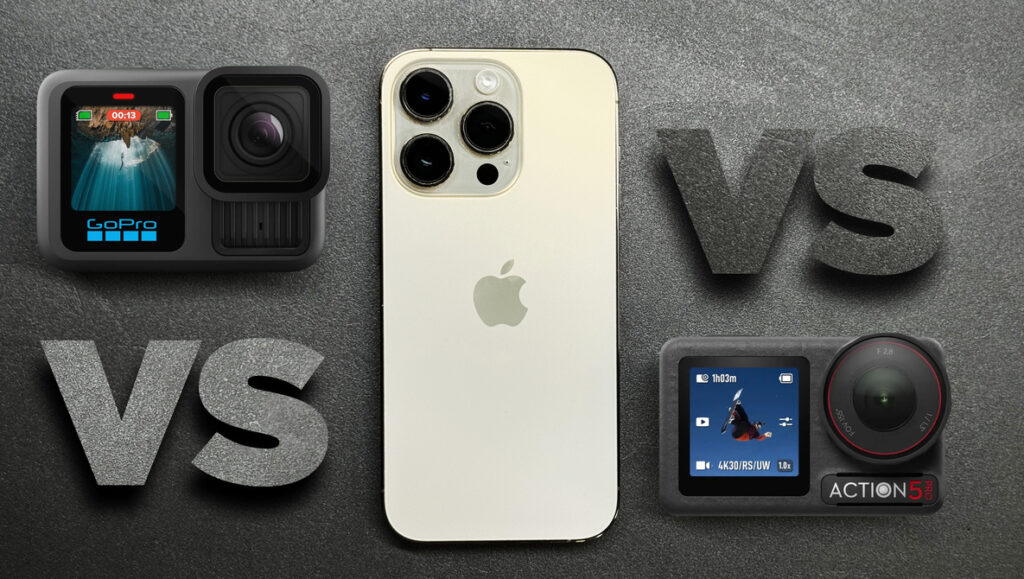For the past few weeks I’ve been shooting with the latest GoPro Hero 13 Black and the new DJI Action 5 Pro action camera. To confuse things a bit, I also tested it against an Apple iPhone. Can older “professional” model iPhones produce videos that compete with these new, cutting-edge action cameras? Let’s find out.
The idea of using an iPhone as an action camera is not a new proposition. But using an iPhone instead of buying an action camera is something my business partner Lee Morris has been vocal about for years. When DJI released the Action 2 cube-sized action camera, Lee noticed that the quality of video output from his new iPhone 13 Pro was as good as, or better than, that from a dedicated action camera. I did.
I don’t dispute that the actual video footage from a “pro” level iPhone is as good or better than an action camera. After all, the sensor is larger and the phone has three unique lenses. But the truth is, I honestly don’t know how the iPhone will compare to the latest products from DJI and GoPro. Maybe Lee is right and I’ve been fooled by all the fancy marketing surrounding these action cameras. Well, that’s what I’m trying to find out in the video above.
For those of you who aren’t familiar with the video these modern action cameras offer, the most notable features for anyone who shoots for YouTube, supplements their photography business with video, or even shoots commercials. Let’s summarize some of them. Sometimes videos.

- Price: $399 base, $449+ with accessories
- Sensor size: 27.6 MP 1/1.9 inch CMOS
- Frame rate (16:9 aspect ratio): 5.3K at 24, 30, and 60 fps. 4K at 24, 30, 60, and 120 fps. 2.7K at 240 fps
- Maximum field of view: 177 degrees at f/2.5
- Stabilization mode: HyperSmooth 6.0
- HDR video: 5.3K at 24 and 30 fps. 4K at 24, 30, and 60 fps.
- Internal memory: none
Read detailed specifications on GoPro’s website.

- Price: $349 base, $449+ with accessories
- Sensor size: 40 MP 1/1.3 inch CMOS
- Frame rate (16:9 aspect ratio): 4K at 24, 30, 60, 120 fps. 1080p at 240fps
- Maximum field of view: 155 degrees at f/2.8
- Stabilization mode: RockSteady 3.0
- HDR video: 4K at 24, 30, and 60 fps.
- Built-in memory: 47GB
For detailed specifications, please visit DJI’s website.
For this comparison, Lee and I thought it would make sense to use the older iPhone, since many people keep a second iPhone after upgrading to a newer one. Also, new iPhones can be two to three times more expensive than these action cameras, so the only way you can compare this test price-wise is with a used or older iPhone. My current iPhone is a 15 Pro and Lee just upgraded to an iPhone 16 Pro, so the best “desktop drawer” iPhone we had was his iPhone 14 Pro. Below are the specs of this smartphone for comparison.

- Price: $400 – $650 depending on used condition
- Sensor size: 40 MP 1/1.28 inch CMOS
- Frame rate (16:9 aspect ratio): 4K at 24, 30, and 60 fps. 1080p at 120fps. 720 at 240 fps
- Maximum field of view: 120 degrees at f/2.2
- Stabilization mode: Action mode
- HDR video: 4K, 60 fps.
- Internal memory: 128 GB to 1 TB
For detailed specifications, please visit Apple’s website.
Of course, the latest iPhone 16 Pro offers 4K 120 and 240 fps slow motion, as well as a few other minor upgrades.
result
After shooting a ton of footage with all three of these cameras, what did we find? It’s impossible to explain the differences in video quality in a post, so be sure to watch the video above to see how each camera See exactly how it performed in resolution, dynamic range, stabilization, and slow motion. Personally, my preference has usually been the DJI Action 5 Pro after syncing all my files and being able to go back and forth between them. The GoPro Hero 13 looked more natural in some cases, and some of the Hero 13’s slow motion options produced better footage. But when it comes to low light, ease of use, and dynamic range at regular 4K/60 fps settings, to my eyes, the DJI Action 5 Pro looks the best 9 times out of 10.

That said, the real purpose of this test wasn’t necessarily just to compare two action cameras. What did you think about using the fairly new iPhone Pro as an action camera? The phone worked surprisingly well in bright light and in situations where you could just pull the phone out of your pocket and shoot. But when it came to actually having to mount a camera on a moving vehicle, in and around water, or even attach it to your body, the iPhone felt out of place. It often even felt reckless to put such an expensive camera phone in a situation where it could easily be broken or destroyed. Low-light video footage was the worst ever, and the cropped resolution quality caused problems when I turned on stabilization in action mode. Add to that all the frustration of trying to find footage from your phone and download it to your PC, and the process was difficult at best and often a nightmare.
To really understand how these cameras compare side by side, we recommend watching the featured video in this post. Lee Morris may feel that the iPhone in his pocket has always been his best action camera, but I’m thrilled to be able to say I’ll keep my Action 5 Pro and delegate my iPhone to personal use only. I am.


